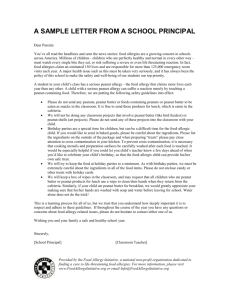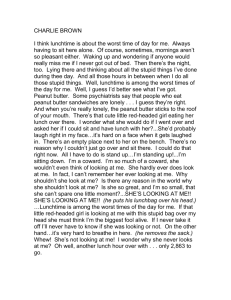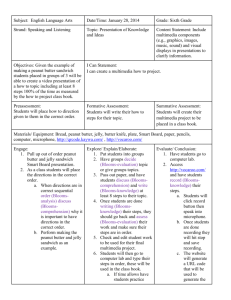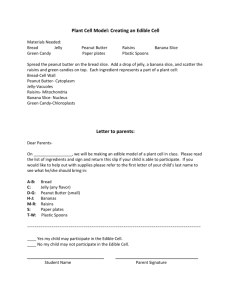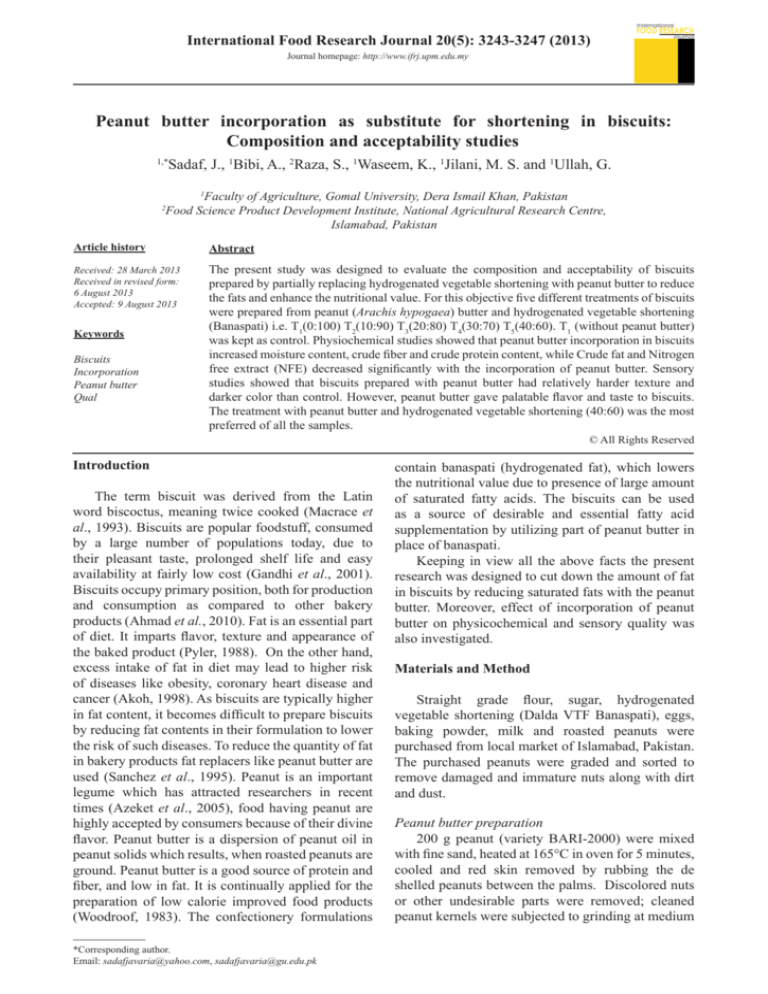
International Food Research Journal 20(5): 3243-3247 (2013)
Journal homepage: http://www.ifrj.upm.edu.my
Peanut butter incorporation as substitute for shortening in biscuits:
Composition and acceptability studies
Sadaf, J., 1Bibi, A., 2Raza, S., 1Waseem, K., 1Jilani, M. S. and 1Ullah, G.
1,*
Faculty of Agriculture, Gomal University, Dera Ismail Khan, Pakistan
Food Science Product Development Institute, National Agricultural Research Centre,
Islamabad, Pakistan
1
2
Article history
Abstract
Received: 28 March 2013
Received in revised form:
6 August 2013
Accepted: 9 August 2013
The present study was designed to evaluate the composition and acceptability of biscuits
prepared by partially replacing hydrogenated vegetable shortening with peanut butter to reduce
the fats and enhance the nutritional value. For this objective five different treatments of biscuits
were prepared from peanut (Arachis hypogaea) butter and hydrogenated vegetable shortening
(Banaspati) i.e. T1(0:100) T2(10:90) T3(20:80) T4(30:70) T5(40:60). T1 (without peanut butter)
was kept as control. Physiochemical studies showed that peanut butter incorporation in biscuits
increased moisture content, crude fiber and crude protein content, while Crude fat and Nitrogen
free extract (NFE) decreased significantly with the incorporation of peanut butter. Sensory
studies showed that biscuits prepared with peanut butter had relatively harder texture and
darker color than control. However, peanut butter gave palatable flavor and taste to biscuits.
The treatment with peanut butter and hydrogenated vegetable shortening (40:60) was the most
preferred of all the samples.
Keywords
Biscuits
Incorporation
Peanut butter
Qual
© All Rights Reserved
Introduction
The term biscuit was derived from the Latin
word biscoctus, meaning twice cooked (Macrace et
al., 1993). Biscuits are popular foodstuff, consumed
by a large number of populations today, due to
their pleasant taste, prolonged shelf life and easy
availability at fairly low cost (Gandhi et al., 2001).
Biscuits occupy primary position, both for production
and consumption as compared to other bakery
products (Ahmad et al., 2010). Fat is an essential part
of diet. It imparts flavor, texture and appearance of
the baked product (Pyler, 1988). On the other hand,
excess intake of fat in diet may lead to higher risk
of diseases like obesity, coronary heart disease and
cancer (Akoh, 1998). As biscuits are typically higher
in fat content, it becomes difficult to prepare biscuits
by reducing fat contents in their formulation to lower
the risk of such diseases. To reduce the quantity of fat
in bakery products fat replacers like peanut butter are
used (Sanchez et al., 1995). Peanut is an important
legume which has attracted researchers in recent
times (Azeket et al., 2005), food having peanut are
highly accepted by consumers because of their divine
flavor. Peanut butter is a dispersion of peanut oil in
peanut solids which results, when roasted peanuts are
ground. Peanut butter is a good source of protein and
fiber, and low in fat. It is continually applied for the
preparation of low calorie improved food products
(Woodroof, 1983). The confectionery formulations
*Corresponding author.
Email: sadafjavaria@yahoo.com, sadafjavaria@gu.edu.pk
contain banaspati (hydrogenated fat), which lowers
the nutritional value due to presence of large amount
of saturated fatty acids. The biscuits can be used
as a source of desirable and essential fatty acid
supplementation by utilizing part of peanut butter in
place of banaspati.
Keeping in view all the above facts the present
research was designed to cut down the amount of fat
in biscuits by reducing saturated fats with the peanut
butter. Moreover, effect of incorporation of peanut
butter on physicochemical and sensory quality was
also investigated.
Materials and Method
Straight grade flour, sugar, hydrogenated
vegetable shortening (Dalda VTF Banaspati), eggs,
baking powder, milk and roasted peanuts were
purchased from local market of Islamabad, Pakistan.
The purchased peanuts were graded and sorted to
remove damaged and immature nuts along with dirt
and dust.
Peanut butter preparation
200 g peanut (variety BARI-2000) were mixed
with fine sand, heated at 165°C in oven for 5 minutes,
cooled and red skin removed by rubbing the de
shelled peanuts between the palms. Discolored nuts
or other undesirable parts were removed; cleaned
peanut kernels were subjected to grinding at medium
3244
Sadaf et al./IFRJ 20(5): 3243-3247
speed in domestic mixer for 2 minutes. The ground
product was spread on aluminum tray and left for
3 h followed by de-oiling, when oil separation was
noticed on the surface of peanut butter. The peanut
butter was packed in airtight glass container and
stored in refrigerator (10°C) to prevent rancidity.
Biscuits preparation
The biscuits were prepared as per standard recipe
of AACC (2000). For the preparation of 45 biscuits
400 g of refined wheat flour and 2.0 g baking powder
were mixed and sieved twice together. Powdered
sugar (200 g) and hydrogenated vegetable shortening
/peanut butter (as per treatment) were creamed in a
dough mixer. The egg (40 g), sieved flour and baking
powder were mixed together at slow speed for 10
minutes and then 20 ml milk was also added, mixed
with other ingredients at high speed for 20 minutes.
The mixing of the dough was continued until it reached
the full development. The biscuits dough was sheeted
on a wooden platform to a thickness of 3 mm using
wooden rolling pin. The dough was cut into circular
shape using a metallic cutter and arranged on a baking
tray for baking. The biscuits were baked at 180°C for
25 minutes. Then biscuits were cooled and packed in
polypropylene (40 μ thickness) pouches and quality
evaluated after 24 h. The treatment plan used in the
preparation of biscuits is given in Table 1.
Chemical analysis
Moisture, crude protein, crude fat and crude fiber
of peanut butter and biscuits were determined in
triplicate by the standard methods of AACC (2000).
Nitrogen free extract was calculated by difference.
Sensory evaluation
The samples were subjected to sensory evaluation
to determine consumer preferences among the
different samples, for color, texture, flavor and overall
acceptability by the method described by Meilgaard
et al. (2007). A panel of 10 judges was involved in
the sensory evaluation exercise. The samples were
presented in coded identical transparent polyethylene
bags and were tested individually. The order of
presentation of samples was completely randomized.
The panelists rinsed their mouth thoroughly with
water after testing each sample and waited for a
minute before proceedings to test the next sample. The
sensory evaluation was based on a 9-point hedonic
scale, where (9) represented “liked extremely” and
(1) is “disliked extremely”.
Statistical analysis
The research was designed in completely
randomized design (CRD). Data were analyzed with
Table 1. Treatment plan: Peanut butter to hydrogenated
vegetable shortening (Banaspati) ratio in standard recipe
of biscuits
Treatments
T1
T2
T3
T4
T5
Peanut butter: Bansspati
0:100
10:90
20:80
30:70
40:60
Analysis of variance (ANOVA) and LSD was used
to assess the location of the significant differences
among the mean values by the method of steel et al.
(1997).
Results and Discussion
Chemical composition of peanut butter was:
moisture (1.8%), crude fiber (6%), crude protein
(25%), crude fat (45%) and NEF (20 %).
Effect of peanut butter incorporation levels on
physicochemical characteristics of biscuit
Moisture
The data indicated that moisture progressively
increased with increasing levels of peanut butter in
biscuits (Table 2). Highest moisture (2.62%) was
recorded in T5 followed by T4 (2.04%) in biscuits
having peanut butter and hydrogenated vegetable
shortening (30:70) which was statistically similar
with T3. The lowest moisture (1.26%) was observed
in T1 (biscuits prepared without peanut butter). Sudha
et al. (2007) reported that gradual increase in moisture
content of biscuits with the increase of peanut butter
supplementation might be attributed to higher amount
of fiber in peanut butter and fiber has strong affinity
for water and products containing fiber.
Crude fiber
High amount of crude fiber is beneficial for their
role in the regulation of intestinal transit, lower the
serum cholesterol level, constipation, diabetes, colon
and breast cancer (Ishida et al., 2000). The data
about crude fiber indicated that crude fiber gradually
increased with increasing levels of peanut butter
(Table 2). Highest crude fiber (6.48%) was recorded
in T5, while lowest fiber (1.23%) was found in
biscuits prepared without peanut butter (T1). The data
was comparable to that of Alozie et al. (2009), who
reported that peanut butter has high fiber content,
however, crude fiber increased in peanut butter
supplemented cakes.
Crude protein
It has been observed from the data that protein
content gradually increased with increasing levels of
3245
Sadaf et al./IFRJ 20(5): 3243-3247
Table 2. Mean values (%) of chemical constituents of biscuits
Treatments
Peanut butter + Hydrogenated
vegetable shortening (0:100)
Peanut butter + Hydrogenated
vegetable shortening (10:90)
Peanut butter + Hydrogenated
vegetable shortening (20:80)
Peanut butter + Hydrogenated
vegetable shortening (30:70)
Peanut butter + Hydrogenated
vegetable shortening (40:60)
Moisture (%)
Crude Fiber (%)
Crude Protein (%)
Crude Fat (%)
NFE (%)
*1.26 ±0.07 d
1.23±0.05 e
6.56±0.0 e
30.44±1.17 a
60.04±1.5 a
1.93±0.03 c
2.43±0.05 d
7.20±0.5 d
29.35±1.28 b
58.48±1.2 b
2.03±0.05 b
3.58±0.07 c
7.92±0.0 c
29.00±1.73 bc
56.83±0.9 c
2.04±0.04
b
4.90 ±0.36 b
8.02±0.1 b
28.53±2.51 c
55.86±1.1 d
2.62±0.06 a
6.48±0.05 a
9.15±0.0 a
28.26±1.9 c
52.82±1.1 e
Average of triplicate determination ± SD (standard deviation)
Means across the rows with different superscripts are significantly different (p ≤ 0.05).
*
peanut butter in biscuits (Table 2). The highest protein
(9.15%) was observed in T5 having peanut butter and
hydrogenated vegetable shortening (40:60). Lowest
protein content (6.56%) was recorded in control
treatment. The results are in line with the results of
Banureka and Mehendran (2009), who reported that
pulses and nuts have high amount of protein, when
these protein rich sources are added to biscuits they
add protein to it.
Crude fat
Peanut butter has around 75% – 80% unsaturated
fats, which is good for heart. Being low calorie diet it
helps to lose weight and is beneficial for the patients
of hypertension. Effect of different levels of peanut
butter supplementation in biscuits was significant
(Table 2). Fat content decreased progressively with
the increasing levels of peanut butter. Highest fat
content (30.44%) was recorded in biscuits prepared
with peanut butter and hydrogenated vegetable
shortening (0:100), which was statically different
from other treatments. Biscuits with lowest fat
content (28.26%) were produced when peanut butter
and hydrogenated vegetable shortening (40:60) were
incorporated. These findings are in accordance with
the findings of Wekwete and Narder et al. (2009), who
observed that peanut butter, had lower fat content
than hydrogenated vegetable shortening. Hence, with
increasing levels of peanut butter as a substitute for
hydrogenated vegetable shortening the fat content of
biscuit decreased, which is good for health.
NFE
The carbohydrate composition (NFE) decreased
significantly in biscuits with the supplementation of
peanut butter (Table 2). It ranged from 52.91-60.04%.
The highest NFE content (60.04%) was recorded
in control treatment (T1), which was statically
dissimilar with all the other treatments. Lowest fat
content (52.91%) was recorded for T5, followed by
(55.86%) in T4. No previous study has been reported
Figure 1. Effect of hydrogenated vegetable shortening
substitution with peanut butter on color of biscuits
on effect of peanut butter supplementation on NFE in
baked products. The reason of increase in NFE value
of peanut supplemented biscuits might be higher
protein, fiber, ash and moisture content in peanut
butter in comparison with hydrogenated vegetable
shortening.
Effect of peanut butter incorporation levels on
organoleptic characteristics of biscuit
Significant (P ≤ 0.05) variations were found
among biscuits prepared with different levels of
peanut butter with respect to their color, texture,
flavor and overall acceptability.
Color
There was a significant effect of peanut butter
on color of biscuits (Table 3). The results showed
that the biscuits became darker as levels of peanut
butter increased (Figure 1). Highest score (8.3) was
recorded for T2, which was statistically akin with
the treatments; T1 and T3. Lowest score (7.0) was
recorded in T3 where 60% Banaspati and 40% peanut
butter were used as raw materials to prepare biscuits.
The results are in line with the results of a number of
researchers; Siddiqui (2000); Claughton and Pearce
(1989) and Kailasapathy et al. (1985), who observed
the similar trends. The reason of darker color of the
biscuits was might be high level of protein present in
the peanut butter. As protein reacts with carbohydrates
during baking, Maillard reaction takes place which
imparts darker color to biscuits.
Sadaf et al./IFRJ 20(5): 3243-3247
3246
Table 3. Effect of Hydrogenated vegetable shortening substitution with peanut butter on sensory
attributes of biscuits
Treatments
Peanut butter + Hydrogenated
vegetable shortening (0:100)
Peanut butter + Hydrogenated
vegetable shortening (10:90)
Peanut butter + Hydrogenated
vegetable shortening (20:80)
Peanut butter + Hydrogenated
vegetable shortening (30:70)
Peanut butter + Hydrogenated
vegetable shortening (40:60)
Color
Taste
Texture
Flavor
Overall acceptability
8.0±0.7 a
7.0±0.6 d
8.5±0.3 a
7.0±0.2 d
7.62±0.6 a
8.33±0.5 a
7.5± 0.5 cd
8.0±0.1 ab
7.0±0.3 d
7.70±0.11 a
8.0±0.6 a
8.0±0.2 bc
7.5±0.6 bc
7.16±0.2 c
7.66±0.13 a
7.33±0.9 b
8.5±0.4 ab
7.33±0.4 bc
8.0±0.28 b
7.79±0.9 a
7.0 ±0.7 b
9.0±0.3 a
7.0±0.15 c
9.0±0.5 a
8.0±0.15 a
Average of triplicate determination ± SD (standard deviation)
Means across the rows with different superscripts are significantly different (p ≤ 0.05).
*
Flavor
Flavor of biscuits progressively increased with
increasing levels of peanut butter (Table 3). The
highest score (9) was recorded for T5, while lowest
score (7) was recorded for control treatment. Similar
results were observed by Siddiqui (2000), who found
that peanut butter imparted delicious flavor to biscuits
which was liked.
hydrogenated vegetable shortening of the biscuits not
only increased the protein content but it also reduced
the fat contents. The most acceptable formulation was
peanut butter and hydrogenated vegetable shortening
(40:60). Peanut butter also imparted better flavor
to biscuits. Biscuits with this formulation should
be made and marketed on large scale to provide
nutritious, healthy confectionary to consumers.
Texture
The data reveled that score for texture of biscuits
was significantly decreased with increasing levels
of peanut butter supplementation (Table 3). Highest
score (8.5) was recorded for biscuits formulated with
peanut butter and hydrogenated vegetable shortening
(0:100), while lowest score (7) was recorded for the
samples made up of peanut butter and hydrogenated
vegetable shortening (40:60). Siddiqui (2000);
Claughton and Pearce (1989) observed the similar
results. They observed that the decrease in texture
score of biscuits was due to the higher protein present
in peanut butter which resulted in poor entrapment
of air during dough mixing and made the biscuits
harder.
References
Overall acceptability
The results revealed that all the treatments were
in acceptable range (Table 3). The highest score (8)
was recorded for biscuits prepared with peanut butter
and hydrogenated vegetable shortening (40:60),
while lowest score (7.62) was recorded for samples
prepared with peanut butter and hydrogenated
vegetable shortening (0:100). Siddiqui (2000) also
reported similar trends.
Conclusion
It has been concluded from the present study
that biscuits produced with the incorporation of
peanut butter to reduce the quantity of hydrogenated
vegetable shortening have shown acceptable quality
characteristics. This substitution of peanut butter for
AACC. 2000. Approved methods of American association
of cereal chemists. American Association of Cereal
Chemists. USA: Saint Paul.
Ahmad, A., Imran, U. H., Ashraf, M. and Saeed, M. K.
2010. Profile analysis (TPA) of cakes supplemented
with soy flour. Pakistan Journal of Science 26 (1): 2127
Akoh, K. 1998. Scientific status summary: Fat replacers.
Food Technology Magazine 52 (3): 47-53.
Alozie, Y. E., Udofia, U. S., Lawal, O. and Anni, I. F. 2009.
Nutrient composition and sensory properties of cakes
made from wheat and African yam bean flour blends.
Journal of Food Technology 7(4): 115-118.
Anjum, F. M., Butt, M. S., Ahmad, N. and Ahmad,
I. 2002. Phytat and mineral contents in different
milling fractions of some Pakistani spring wheats.
International Journal of Food Science and Technology
37 (1): 13-17.
Azeket, M. A., Fretzdorft, B., Buening, P. H., Holzapfel,
W. and Betsche, T. 2005. Nutritional value of African
yam bean (Sphenostylis stenocarpa L.): improvement
by lactic acid fermentation. Journal of Food Science
and Agriculture 85 (6): 963-970.
Banureka, V. D. and Mahendran, T. 2009. Formulation of
wheat-soybean biscuits and their qualiy characteristics.
Tropical Agricultural Research and Extension 12 (2):
62-66.
Claughton, S. M. and Pearce, R. J. 1989. Protein enrichment
of sugar snap cookies with sunflower protein isolate.
Journal of Food Science 54 (2): 354-356.
Gandhi, A. P., Kotwaliwale, N., Kawalkar, J. D.,
Srivastava, C. V., Parihar, S. and Raghu, N. P. 2001.
Effect of incorporation of defatted soy flour on the
quality sweet biscuits. Journal of Food Science and
Sadaf et al./IFRJ 20(5): 3243-3247
Technology 38: 502-503.
Ishida, H., Suzuno, H., Sugiyama, N., Innami, S., Todokoro,
T. and Maekawa., A. 2000. Nutritive evaluation on
chemical components of leaves, stalks and stems of
sweet potatoes (Ipomea batatas Poir). Food Chemistry
68 (3): 359-367.
Kailasapathy. K., Perera, P. A. J. and Mac-Neil, J. H.
1985. Improved nutritional value in wheat bread by
fortification with full fat winged bean flour. Journal of
Food Science 50(3): 1693-1696
Larmond, E. 1977. Laboratory methods of sensory
evaluation of food. p.44. Canada: Dept. Agri.
Publications.
Macrae, R. R., Robinson, K. and Sacdler, M. J. 1993.
Encyclopedia of Food Science. Food technology and
Nurtrition. p. 345. London: Academic Press Harcourt
Brace Jovanovich Publications.
Meilgaard, M. C., Civille, G. V. and Carr, B.T. 2007.
Sensory evaluation techniques, 4th edition. USA: CRC
Press, Boca Raton.
Pyler, E. J. 1988. Baking science and technology. 3rd
edition. Pp. 854-857. USA: Sosland publishing.
Sanchez, C., Klopfenstein, C. F. and Walker, G. E.
1995. Use of carbohydrate-based fat substitute and
emulsifying agents in reduced fat short bread cookies.
Cereal Chemistry 72(1): 25-29.
Siddiqui, N. R .2000. Effect of artificial sweeteners on the
quality of cakes and biscuits. Faisalabad, Pakistan:
Agriculture University, MSc thesis
Steel, R., Torrie, J. and Dickey, D. 1997. Principles and
Procedures of Statistics. Biometrical. Approach, 3rd
Ed. USA: McGraw Hill Book Co.
Sudha, M. L., Vetrimani, R. and Leelavathi, K. 2007.
Influence of fiber from different cereals on the
rheological characteristics of wheat flour dough and on
biscuit quality. Food Chemistry 100(4): 1365-1370.
Wekwete, B. S. and Navder, K. P. 2009. Effects of avocado
fruit puree and oatrim as fat replacers on the physical,
textural and sensory properties of oatmeal cookies.
Journal of Food Quality 31(2): 31- 144.
Woodroof, J. G. 1983. Peanuts production, processing,
products 3th edn, Pp 8-10. Westport: AVl Publishing
Company Inc.
3247



